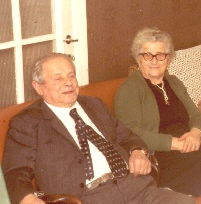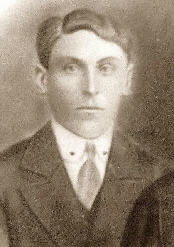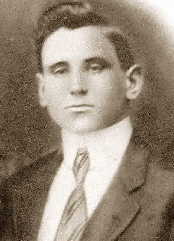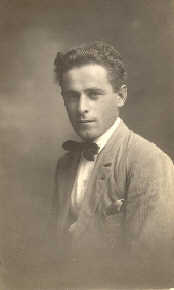


Long Afterwards
Antonio with his Wife Antonia
|
By
Renzo Rocconi
Great-Nephew of the Four Rocconi Brothers
Who Served in the Great War
|
My name is Renzo Rocconi, I live near Venice, Italy. I'm a great enthusiast of World War I history, also because I have a family interest. I have an interesting and for some aspects "out of ordinary" story to tell you.
Although I'm Italian born, my family origin comes from a small island on the
Adriatic Sea, Cres-Losinj Island (or Cherso-Lussino as it is known in the Italian language), now under Croatian State, but formerly Yugoslavia, Italy and Austro-Hungarian Empire. Actually my original family name is Ruconich. It was Italianized in 1926 by Italian Fascism into Rocconi, and Slavized again in 1946 by Communist Yugoslavia into Rukonic).
My grandfather was born in year 1905 (died in 1988) and was forced to
change his family name 2 times, so that now I have relatives with all three versions...
My grandfather was the 10th of a total of 15 brothers and sisters (although
2 of them died infants). The 4 eldest brothers of my grandfather fought in World War I, and only the 4th and youngest survived.
Recently I devoted plenty of my energy and time to reconstruct their doings
during war, and where and how they died.
Domenik (aka Domenico) Ruconich was born on the 2nd October 1893 in
Ossero, Neresine, Istria (now town of Osor, Cres Island, Croatia). He was a farmer and in 1914, when World War I broke out, he was enlisted in the Austro-Hungarian Army and did his military training in the Istrian city-port of Pola (now Pula). He was assigned to the 37th Infantry Regiment (Dalmatian), 3rd Company ("Infanterist des kuk. Landwehrinfanterieregiments N° 37, 3 Feldkompagnie"), 58th Division.
With his Regiment he was sent against Serbia, still I don't know yet how many campaigns he fought there and where exactly in Serbia. His Regiment was then moved to the Italian Isonzo front in 1915, where his unit was directly involved in the first 4 Italian Isonzo River front offensives. During the 4th Italian offensive an Austro-Hungarian night counter-attack to recover a hill nearby the city of Gorizia was fatal for
Him. He died on 20 November 1915 in Oslavia, near Gorizia, and, according to my information, he was buried there on the very same day.
I visited Oslavia last year, where there is a huge Italian World War I memorial and cemetery. About 500 hundred Austro-Hungarian soldiers are buried there as well, but his name there is not. I don't know how he died and there is no grave with his name anymore and anywhere.
Johan (aka Giovanni, aka Ivan) Ruconich was born on the 16th October
1894 in Ossero, Neresine, Istria (now Osor, Cres Island, Croatia). He was also a farmer and in 1914, when World War I broke out, he was enlisted in the Austro-Hungarian Army and did his military training in the Istrian city-port of Pola (now Pula), together with his eldest brother Domenik. (There is no known photo of Johan.)
From this point his doings become quite a mystery: All I know (from a still living sister, now 97 years old, and from my grandfather memories) is that he was sent to the Eastern front where he disappeared. He sent a few postcards to our family (through military mail) telling such things as: "everything's ok, we are advancing." He also asked father to send him money which later he confirmed to have received.
Then suddenly family didn't hear from him anymore, and what is really more mysterious they never received any official communication from the Austro-Hungarian Army about his fate. He was never declared killed in action, taken prisoner, missing or deserter. Just nothing. After World War I family tried to discover what had become of him, by writing letters to several authorities and to the Red Cross, but to no avail.
More recently I made two requests to the War Archive in Vienna, hoping at least to discover in which regiment he was enlisted (by tracking regiment movements I could try to discover what happened to him or at least in which area of the front he was), but at the War Archive in Vienna there is no record about him, he is not in any list of casualties, soldiers taken prisoners, soldiers wounded, soldiers declared missing.
There is a remote and fantastic possibility that I might have relatives somewhere in Eastern Europe, if he survived. But very probably he was killed somewhere, perhaps died prisoner. Still my research is going on, trying to discover alternative sources. Any help is welcome, from anybody. I also don't have any picture of him, which adds mystery to mystery.
Mario Ruconich was born on the 3rd November 1895 in Ossero, Neresine,
Istria (now Osor, Cres Island, Croatia). He was a sailor, so when World War I broke out he must have been abroad. The last ship he was a crew member was named "Argentina" (I don't know if it was a cargo or a passenger line), and this ship must have been confiscated by the US Government because under Austro-Hungarian flag.
I suppose that in order to avoid being kept captive or worse, sent home where he would have been enlisted in the Austro-Hungarian Army like his two eldest brothers, he decided to volunteer in the US Army, so he entered US Army from Michigan and was enlisted in January 1917 (3 months before USA entered war) and trained at Columbus Barracks.
He was assigned to the 2nd Division, 23rd Infantry Regiment, Company L, and was enlisted as Private First Class. He was then sent to France and, among others, with his regiment he fought in the famous bloody and ferocious battle of "Belleau Wood", which he survived, but only to lose his young life few days later, during the capture of the village of Vaux, Chateau Thierry sector, and the nearby woods.
With his company he started the attack at 6.00 pm on the 1st of July 1918 to the southern edge of the northern part of "Bois de la Roche" (Rock Wood), just north north-east of the village of Vaux. At about 6.15 pm he was killed by German machine gun fire. He was hit in the head, with a bullet hole just above right eye, so I presume he died instantly. His body was found at 10 pm feet to feet with that of Sgt. Jacob Mannis, ten feet from the bodies of Pvt. Charles A. Simpson, Cpl. Frank H. Collings (all of them members of 23rd Infantry Regiment, Company L, 2nd Division)and a dead German soldier. A report of his death was signed by Sgt. Thomas Bauer.

Vaux - Where Mario Fell and His Burial Place
As you see, he was on the opposite side of his eldest brothers, so in my family war put "brother against brother... " He now rests in peace in the Oise-Aisne American World War I Cemetery, in Fere-en-Tardenois, north of Chateau Thierry (about 80 km east of Paris, on the highway to Reims).
In August 2003, together with my wife, I visited his grave and took ictures of it and also of the village of Vaux and Bois de la Roche where he died, first relative of his family to go there and after 85 years. I brought these pictures to his still living sister who very well remembers him. She cried when she saw the pictures (there are one more sister and two brothers also living, but they don't remember him because they were infants or just a couple of years old when he left).
Anton (aka Antonio) Ruconich was born on the 7th March 1897 in Ossero, Neresine, Istria (now Osor, Cres Island, Croatia). He also was a farmer In 1915 he became 18 years old, so that he was also conscripted into the Austro-Hungarian Army. He did his military training in the Istrian city-port of Pola (now Pula) like his 2 eldest brothers.
He was assigned to the 1st Infantry Regiment, 20th Company ("Landsturminfanterist des kuk Infanterieregiments N° 1, 20 Kompagnie"). He was sent on the Eastern front in the Bukowina region (now south west Ukraine, northern Romania, around the Ukrainian city of Czernowitz) where he fought for two years until the Russian collapse and ceasefire. He was declared missing from 28th June till 6th July 1916 (during the famous Brusilov offensive of June 1916), wounded two times, involved in all kinds of fighting, including "man to man" with Russian soldiers. He told us later how he and all his comrades were terrorized by Cossacks, Russian Cavalry, to which they could just no make any effective opposition, automatic machine guns were few and unreliable.
Another interesting fact I remember he used to tell is that he and his comrades always tried to throw away, far from themselves, all cartridge cases, because in case Russians took them prisoners they had a chance to survive, otherwise if Russians found them surrounded by fired cartridge cases ("patronen") they could kill them on the spot (he saw with his eyes a Hungarian soldier killed with swords by Russians for this reason).

The Rocconi Family, Christmas 1983
Antonio at the Table Head; Author Third from Right
But after all he did and saw he survived and died 88 years old in September 1985. I always remember his incredible stories of his World War I experience. Since I was a young boy I was listening to his memories with open mouth. I also remember how one time, being just a young "curious" boy, I asked him "do you remember to
having killed somebody ??" Yes, he remembered how he killed a Russian soldier who was crawling towards his trench throwing hand grenades against him. He said he targeted him with his rifle, shot and then saw he was not moving anymore...My uncle also said: "that Russian soldier is the only one I'm definitely sure I killed"...
You know, I would like to find the family of that Russian soldier and ask forgiveness. War turns men into beasts, but my uncle was not like that, he was just a man trying to survive in a inferno which was engulfing the young lives of millions of European men, and which engulfed 3 of his brothers.
|
Sources and Thanks: The author would like to correspond with other individuals interested in the Great War and in the individuals who served.
RENZO ROCCONI
VIA PALESTRO 16
30038 SPINEA (VE)
ITALY
Email: bravo_sx100@yahoo.com
|
|
|

To find other features on La Grande Guerra visit our
Directory Page
|
For Great War Society
Membership Information

Click on Icon |
For further information on the events of 1914-1918
visit the homepage of
The Great War Society
|
Additions and comments on these pages may be directed to:
Michael E. Hanlon
(medwardh@hotmail.com) regarding content,
or toLeo Benedetti (leoben@silcon.com)
regarding form and function.
Original artwork & copy; © 1998-2000, The
Great War Society
|









